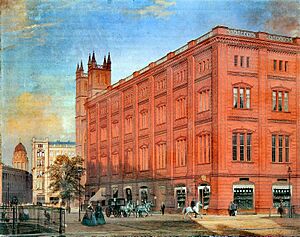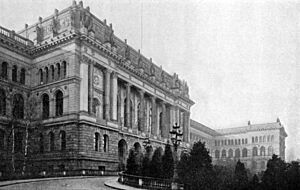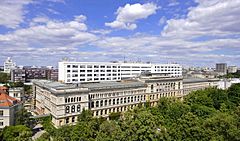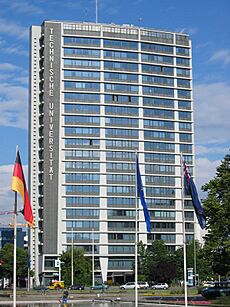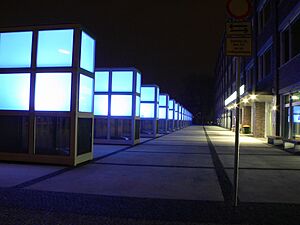Technische Universität Berlin facts for kids
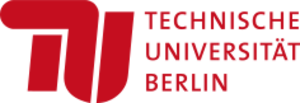 |
|
| Motto |
Wir haben die Ideen für die Zukunft. Zum Nutzen der Gesellschaft.
|
|---|---|
|
Motto in English
|
We've got the brains for the future. For the benefit of society. |
| Type | Public |
| Established |
|
| Affiliation | TIME, TU9, EUA, CESAER, DFG, SEFI, PEGASUS, German Excellence Universities, Berlin University Alliance |
| Budget | €659.3 million (2022) |
| President | Geraldine Rauch (since 2022) |
|
Academic staff
|
3,120 |
|
Administrative staff
|
2,258 |
| Students | 35,570 |
| Location |
,
Germany
52°30′43″N 13°19′35″E / 52.51194°N 13.32639°E |
| Campus | Urban |
 |
|
Technische Universität Berlin (often called TU Berlin) is a large public research university in Berlin, Germany. It was the first German university to use the name "Technische Universität," which means "university of technology."
Many famous people have studied or worked at TU Berlin. These include ten Nobel Prize winners and Konrad Zuse, who created the first fully working programmable computer.
TU Berlin is part of important groups like TU9, which includes the biggest and best German technology institutes. It is also part of the Top International Managers in Engineering (TIME) network. This network helps students exchange between top engineering schools.
The university was the first to offer a degree in Industrial Engineering and Management. This course was created in 1926 to help students learn both technical skills and how to manage a company.
TU Berlin has a high number of international students, with almost 27% in 2019. It is also part of the Berlin University Alliance and is known as a "University of Excellence."
| Top - 0-9 A B C D E F G H I J K L M N O P Q R S T U V W X Y Z |
History of TU Berlin
TU Berlin has a long history, starting from several older schools. On April 1, 1879, the "Royal Technical Academy of Berlin" was formed. This happened when two older schools, the "Royal Trade Academy" (founded in 1827) and the "Royal Building Academy" (founded in 1799), joined together.
In 1899, this academy became the first technical school in Germany to offer doctorate degrees. This was a big step for engineering education.
In 1916, the "Royal Mining Academy of Berlin" also joined the Royal Technical Academy. This mining school was very old, started in 1770 by King Frederick the Great.
After Berlin grew bigger in 1920, the "Royal Technical Academy of Berlin" was renamed "Technische Hochschule zu Berlin" (TH Berlin). In the 1930s, there were plans to expand the campus. However, these plans were stopped by World War II.
During World War II, parts of the main university building were destroyed in bombings in November 1943. The university stopped operating on April 20, 1945, due to fighting.
The school reopened on April 9, 1946, with a new name: "Technische Universität Berlin." Since 2009, TU Berlin has been home to two special innovation centers.
What's in a Name?
The university's official rule is that only its German name, Technische Universität Berlin (TU Berlin), should be used everywhere. This helps create a strong identity for the university. Its name should not be translated into English.
Campus Life and Locations
TU Berlin has a large campus that covers about 604,000 square meters (about 6.5 million square feet). This area is spread across different locations in Berlin.
The main campus is located in the Charlottenburg-Wilmersdorf area of Berlin. In October 2015, the university had about 33,933 students studying 90 different subjects across its seven schools.
From 2012 to 2022, TU Berlin also had a campus in El Gouna, Egypt. This campus was a scientific and academic office that offered courses from TU Berlin. The university also has a program called Global Production Engineering and Management at the Vietnamese-German University in Ho Chi Minh City.
How TU Berlin is Organized
Since 2002, TU Berlin has been divided into seven main faculties (or schools) and several institutes. Each faculty focuses on different areas of study:
- Faculty I – Humanities and Educational Sciences: This faculty studies subjects like history, philosophy, art history, education, and languages.
- Faculty II – Mathematics and Natural Sciences: Here, students learn about astronomy, chemistry, physics, and mathematics.
- Faculty III – Process Sciences: This faculty focuses on biotechnology, energy technology, food technology, chemical engineering, environmental technology, and material sciences.
- Faculty IV – Electrical Engineering and Computer Science: This area covers energy and automation, telecommunication, computer engineering, and software.
- Faculty V – Mechanical Engineering and Transport Systems: This faculty deals with fluid mechanics, psychology, automotive and maritime systems, aeronautics, and machine tools.
- Faculty VI – Planning Building Environment: This faculty includes architecture, civil engineering, earth sciences, landscape architecture, ecology, and urban planning.
- Faculty VII – Economics and Management: This faculty teaches about technology management, business administration, economics, and law.
There is also a School of Education (SETUB) and the Central Institute El Gouna.
People at TU Berlin
As of 2015, about 8,455 people work at the university. This includes 338 professors and 2,598 researchers. Many other people work in administration, libraries, and other areas.
Students can also study abroad through programs like ERASMUS programme or the Top Industrial Managers for Europe (TIME) network.
The University Library
The main library for TU Berlin and the Berlin University of the Arts opened in 2004. It holds about 2.9 million books and other materials. The Volkswagen company helped fund the building, so it is sometimes called the "University Library of the TU Berlin and UdK (in the Volkswagen building)."
While many smaller libraries joined to form this main one, some departments still have their own libraries. For example, the Economics and Management school has a library with 340,000 books. The Mathematics department also has its own library.
Famous People from TU Berlin
Many important people have studied or taught at TU Berlin and its older schools. Here are a few examples:
- Wernher von Braun (1912–1977): An engineer who designed the first ballistic missile and later worked on NASA rockets.
- Fritz Haber (1868–1934): A chemist who won the Nobel Prize in Chemistry in 1918.
- Eugene Paul Wigner (1902–1995): A physicist who won the Nobel Prize in Physics in 1963.
- Carl Bosch (1874–1940): A chemist who won the Nobel Prize in Chemistry in 1931.
- Karl Friedrich Schinkel (1781–1841): A famous architect who studied at the Building Academy.
- Konrad Zuse (1910–1995): A computer pioneer who designed the first modern computer.
- Dennis Gabor (1900–1971): A physicist who invented holography and won the Nobel Prize in 1971.
- Hans Geiger (1882–1945): A physicist who helped invent the Geiger counter.
- Ernst Ruska (1906–1988): A physicist who invented the electron microscope and won the Nobel Prize in 1986.
- Wolfgang Paul (1913–1993): A physicist who won the Nobel Prize in 1989.
- Ida Noddack (1896–1978): A chemist nominated three times for the Nobel Prize.
- Elisabeth von Knobelsdorff (1877–1959): An engineer and architect, one of the first women engineers.
University Rankings
| University rankings | ||||||||||
|---|---|---|---|---|---|---|---|---|---|---|
| Overall – Global & National | ||||||||||
|
||||||||||
Universities are often ranked to show how well they are doing. In the QS World University Rankings for 2025, TU Berlin was ranked 147th globally. This made it the 8th best university in Germany.
The Times Higher Education World University Rankings for 2024 placed TU Berlin 136th worldwide. In Germany, it was ranked between 12th and 13th. The Academic Ranking of World Universities for 2023 put TU Berlin between 201st and 300th globally, and between 10th and 19th in Germany.
In 2019, TU Berlin ranked 11th in Germany for the number of its graduates who became top managers.
The German Research Foundation (DFG) is a group that funds research. Their 2018 report showed TU Berlin ranked 24th among all German universities for research. It was 9th in natural sciences and engineering, 14th in computer science, and 5th in electrical engineering. These rankings show the quality of research at the university.
In 2017, the Times Higher Education World University Rankings placed TU Berlin 40th in Engineering & Technology (3rd in Germany) and 36th in Computer Science (4th in Germany). This shows it is one of the top universities globally in these fields.
See also
 In Spanish: Universidad Técnica de Berlín para niños
In Spanish: Universidad Técnica de Berlín para niños
- Universities and research institutions in Berlin
- European Institute of Innovation and Technology
- Free University of Berlin
- Humboldt University of Berlin
- Berlin University of the Arts


